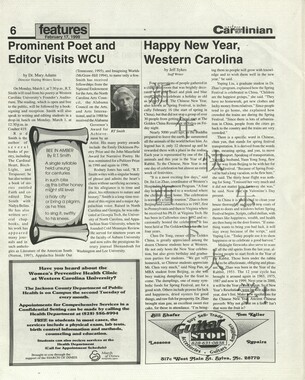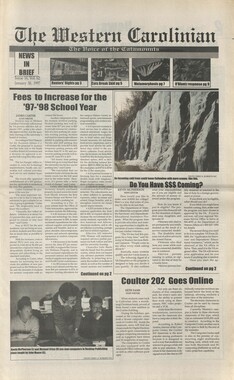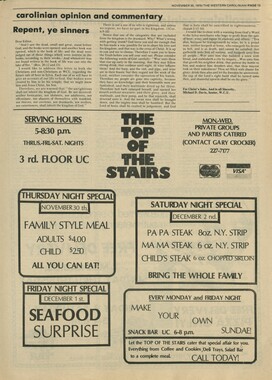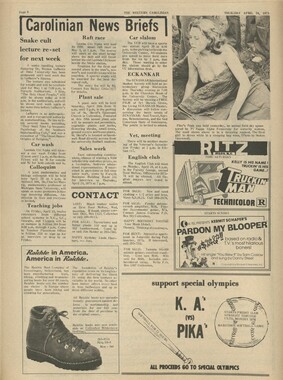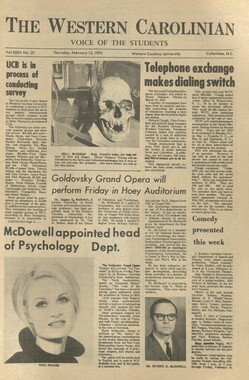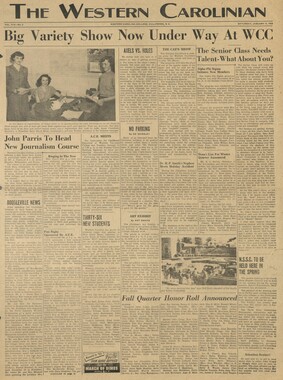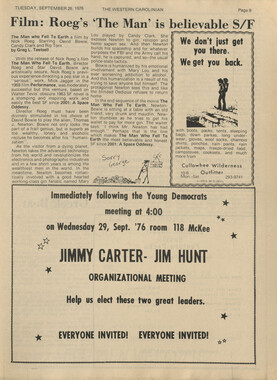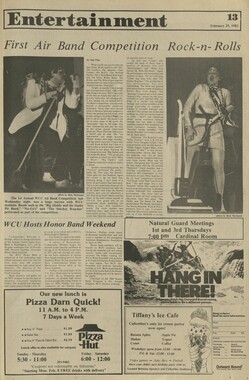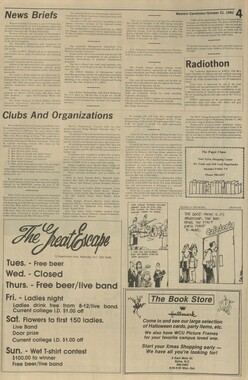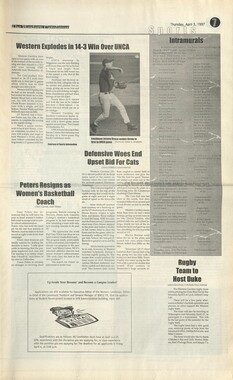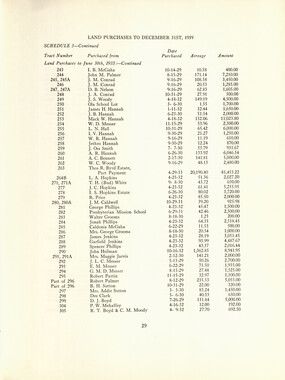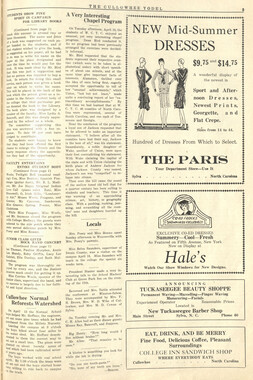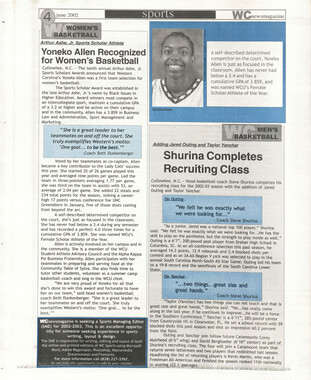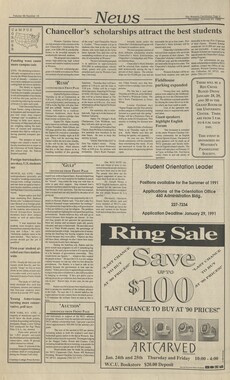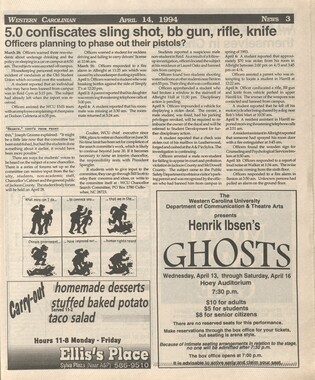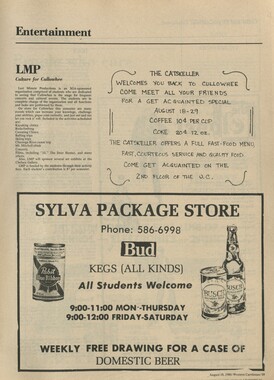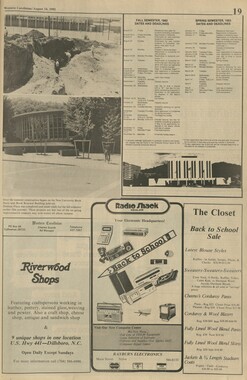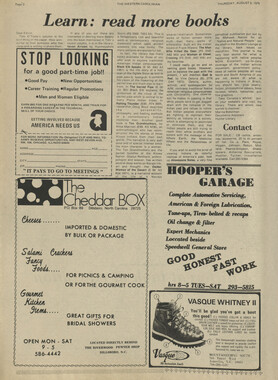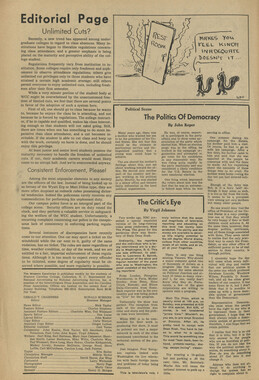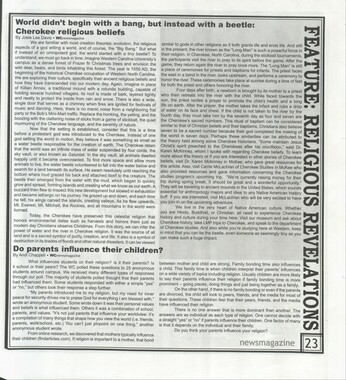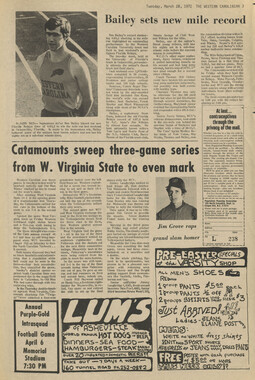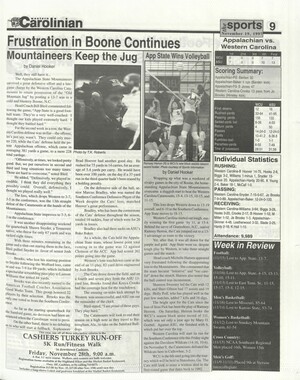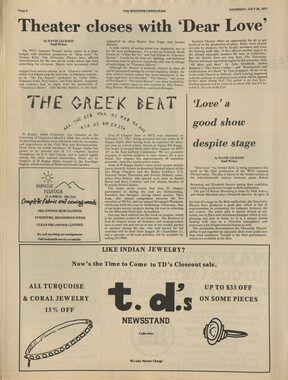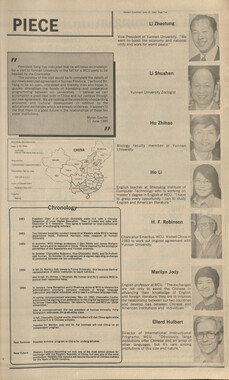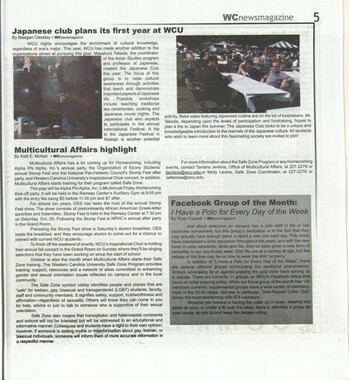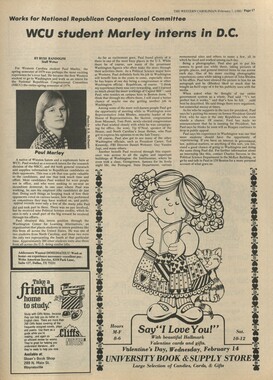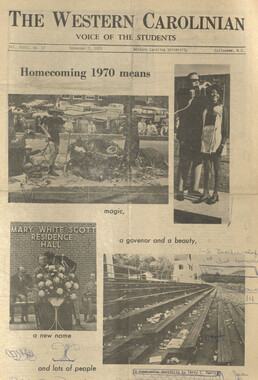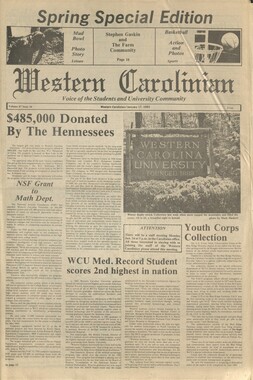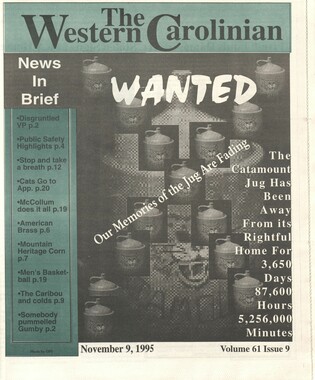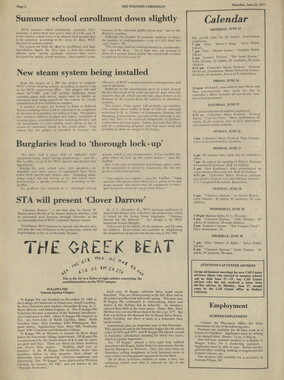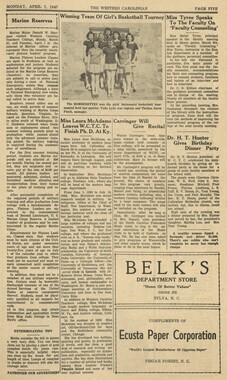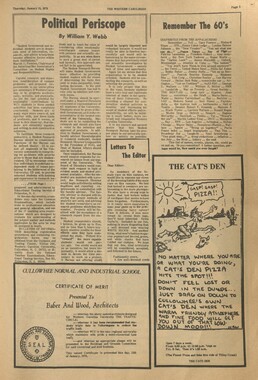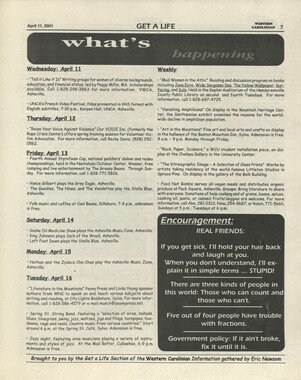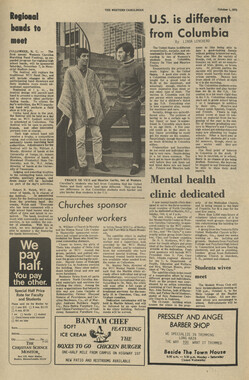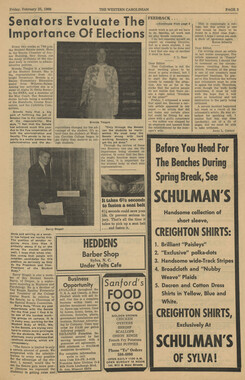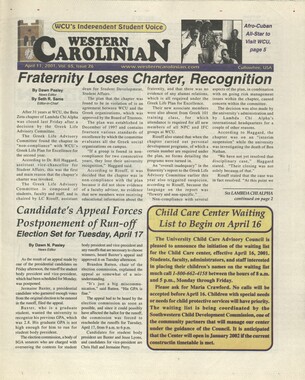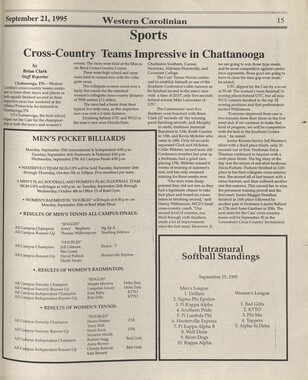Western Carolina University (20)
View all
- Canton Champion Fibre Company (2308)
- Cherokee Traditions (291)
- Civil War in Southern Appalachia (165)
- Craft Revival (1942)
- Great Smoky Mountains - A Park for America (2857)
- Highlights from Western Carolina University (430)
- Horace Kephart (941)
- Journeys Through Jackson (159)
- LGBTQIA+ Archive of Jackson County (85)
- Oral Histories of Western North Carolina (314)
- Picturing Appalachia (6772)
- Stories of Mountain Folk (413)
- Travel Western North Carolina (160)
- Western Carolina University Fine Art Museum Vitreograph Collection (129)
- Western Carolina University Herbarium (92)
- Western Carolina University: Making Memories (708)
- Western Carolina University Publications (2353)
- Western Carolina University Restricted Electronic Theses and Dissertations (146)
- Western North Carolina Regional Maps (71)
- World War II in Southern Appalachia (131)
University of North Carolina Asheville (6)
View all
- Allanstand Cottage Industries (62)
- Appalachian National Park Association (53)
- Bennett, Kelly, 1890-1974 (1388)
- Berry, Walter (76)
- Brasstown Carvers (40)
- Carver, George Washington, 1864?-1943 (26)
- Cathey, Joseph, 1803-1874 (1)
- Champion Fibre Company (233)
- Champion Paper and Fibre Company (297)
- Cherokee Indian Fair Association (16)
- Cherokee Language Program (22)
- Crowe, Amanda (40)
- Edmonston, Thomas Benton, 1842-1907 (7)
- Ensley, A. L. (Abraham Lincoln), 1865-1948 (275)
- Fromer, Irving Rhodes, 1913-1994 (70)
- George Butz (BFS 1907) (46)
- Goodrich, Frances Louisa (120)
- Grant, George Alexander, 1891-1964 (96)
- Heard, Marian Gladys (60)
- Kephart, Calvin, 1883-1969 (15)
- Kephart, Horace, 1862-1931 (313)
- Kephart, Laura, 1862-1954 (39)
- Laney, Gideon Thomas, 1889-1976 (439)
- Masa, George, 1881-1933 (61)
- McElhinney, William Julian, 1896-1953 (44)
- Niggli, Josephina, 1910-1983 (10)
- North Carolina Park Commission (105)
- Osborne, Kezia Stradley (9)
- Owens, Samuel Robert, 1918-1995 (11)
- Penland Weavers and Potters (36)
- Roberts, Vivienne (15)
- Roth, Albert, 1890-1974 (142)
- Schenck, Carl Alwin, 1868-1955 (1)
- Sherrill's Photography Studio (2565)
- Southern Highland Handicraft Guild (127)
- Southern Highlanders, Inc. (71)
- Stalcup, Jesse Bryson (46)
- Stearns, I. K. (213)
- Thompson, James Edward, 1880-1976 (226)
- United States. Indian Arts and Crafts Board (130)
- USFS (683)
- Vance, Zebulon Baird, 1830-1894 (1)
- Weaver, Zebulon, 1872-1948 (58)
- Western Carolina College (230)
- Western Carolina Teachers College (282)
- Western Carolina University (1840)
- Western Carolina University. Mountain Heritage Center (18)
- Whitman, Walt, 1819-1892 (10)
- Wilburn, Hiram Coleman, 1880-1967 (73)
- Williams, Isadora (3)
- Cain, Doreyl Ammons (0)
- Crittenden, Lorraine (0)
- Rhodes, Judy (0)
- Smith, Edward Clark (0)
- Appalachian Region, Southern (2569)
- Asheville (N.C.) (1923)
- Avery County (N.C.) (26)
- Blount County (Tenn.) (169)
- Buncombe County (N.C.) (1672)
- Cherokee County (N.C.) (283)
- Clay County (N.C.) (555)
- Graham County (N.C.) (233)
- Great Smoky Mountains National Park (N.C. and Tenn.) (519)
- Haywood County (N.C.) (3567)
- Henderson County (N.C.) (70)
- Jackson County (N.C.) (4745)
- Knox County (Tenn.) (31)
- Knoxville (Tenn.) (12)
- Lake Santeetlah (N.C.) (10)
- Macon County (N.C.) (420)
- Madison County (N.C.) (215)
- McDowell County (N.C.) (39)
- Mitchell County (N.C.) (132)
- Polk County (N.C.) (35)
- Qualla Boundary (981)
- Rutherford County (N.C.) (76)
- Swain County (N.C.) (2117)
- Transylvania County (N.C.) (270)
- Watauga County (N.C.) (12)
- Waynesville (N.C.) (84)
- Yancey County (N.C.) (72)
- Aerial Photographs (3)
- Aerial Views (60)
- Albums (books) (4)
- Articles (1)
- Artifacts (object Genre) (228)
- Bibliographies (1)
- Biography (general Genre) (2)
- Cards (information Artifacts) (38)
- Clippings (information Artifacts) (191)
- Copybooks (instructional Materials) (3)
- Crafts (art Genres) (622)
- Depictions (visual Works) (21)
- Design Drawings (1)
- Drawings (visual Works) (185)
- Envelopes (73)
- Exhibitions (events) (1)
- Facsimiles (reproductions) (1)
- Fiction (general Genre) (4)
- Financial Records (12)
- Fliers (printed Matter) (67)
- Glass Plate Negatives (381)
- Guidebooks (2)
- Internegatives (10)
- Interviews (815)
- Land Surveys (102)
- Letters (correspondence) (1013)
- Manuscripts (documents) (618)
- Maps (documents) (177)
- Memorandums (25)
- Minutes (administrative Records) (59)
- Negatives (photographs) (5926)
- Newsletters (1290)
- Newspapers (2)
- Notebooks (8)
- Occupation Currency (1)
- Paintings (visual Works) (1)
- Pen And Ink Drawings (1)
- Periodicals (193)
- Personal Narratives (10)
- Photographs (12976)
- Plans (maps) (1)
- Poetry (5)
- Portraits (4535)
- Postcards (329)
- Programs (documents) (151)
- Publications (documents) (2305)
- Questionnaires (65)
- Sayings (literary Genre) (1)
- Scrapbooks (282)
- Sheet Music (2)
- Slides (photographs) (402)
- Songs (musical Compositions) (2)
- Sound Recordings (796)
- Specimens (92)
- Speeches (documents) (15)
- Tintypes (photographs) (8)
- Transcripts (322)
- Video Recordings (physical Artifacts) (23)
- Vitreographs (129)
- Text Messages (0)
- A.L. Ensley Collection (275)
- Appalachian Industrial School Records (7)
- Appalachian National Park Association Records (336)
- Axley-Meroney Collection (2)
- Bayard Wootten Photograph Collection (20)
- Bethel Rural Community Organization Collection (7)
- Blumer Collection (5)
- C.W. Slagle Collection (20)
- Canton Area Historical Museum (2110)
- Carlos C. Campbell Collection (373)
- Cataloochee History Project (64)
- Cherokee Studies Collection (4)
- Daisy Dame Photograph Album (5)
- Daniel Boone VI Collection (1)
- Doris Ulmann Photograph Collection (112)
- Elizabeth H. Lasley Collection (1)
- Elizabeth Woolworth Szold Fleharty Collection (4)
- Frank Fry Collection (95)
- George Masa Collection (173)
- Gideon Laney Collection (452)
- Hazel Scarborough Collection (2)
- Hiram C. Wilburn Papers (28)
- Historic Photographs Collection (236)
- Horace Kephart Collection (861)
- Humbard Collection (33)
- Hunter and Weaver Families Collection (1)
- I. D. Blumenthal Collection (4)
- Isadora Williams Collection (4)
- Jesse Bryson Stalcup Collection (47)
- Jim Thompson Collection (224)
- John B. Battle Collection (7)
- John C. Campbell Folk School Records (80)
- John Parris Collection (6)
- Judaculla Rock project (2)
- Kelly Bennett Collection (1407)
- Love Family Papers (11)
- Major Wiley Parris Civil War Letters (3)
- Map Collection (12)
- McFee-Misemer Civil War Letters (34)
- Mountain Heritage Center Collection (4)
- Norburn - Robertson - Thomson Families Collection (44)
- Pauline Hood Collection (7)
- Pre-Guild Collection (2)
- Qualla Arts and Crafts Mutual Collection (12)
- R.A. Romanes Collection (681)
- Rosser H. Taylor Collection (1)
- Samuel Robert Owens Collection (94)
- Sara Madison Collection (144)
- Sherrill Studio Photo Collection (2558)
- Smoky Mountains Hiking Club Collection (616)
- Stories of Mountain Folk - Radio Programs (374)
- The Reporter, Western Carolina University (510)
- Venoy and Elizabeth Reed Collection (16)
- WCU Gender and Sexuality Oral History Project (32)
- WCU Mountain Heritage Center Oral Histories (25)
- WCU Oral History Collection - Mountain People, Mountain Lives (71)
- WCU Students Newspapers Collection (1784)
- Western North Carolina Tomorrow Black Oral History Project (69)
- William Williams Stringfield Collection (2)
- Zebulon Weaver Collection (109)
- African Americans (390)
- Appalachian Trail (35)
- Artisans (521)
- Cherokee art (84)
- Cherokee artists -- North Carolina (10)
- Cherokee language (21)
- Cherokee pottery (101)
- Cherokee women (208)
- Church buildings (170)
- Civilian Conservation Corps (U.S.) (110)
- College student newspapers and periodicals (1876)
- Dams (107)
- Dance (1023)
- Education (222)
- Floods (61)
- Folk music (1015)
- Forced removal, 1813-1903 (2)
- Forest conservation (220)
- Forests and forestry (1184)
- Gender nonconformity (4)
- Great Smoky Mountains National Park (N.C. and Tenn.) (181)
- Hunting (45)
- Landscape photography (25)
- Logging (118)
- Maps (83)
- Mines and mineral resources (8)
- North Carolina -- Maps (18)
- Paper industry (38)
- Postcards (255)
- Pottery (135)
- Railroad trains (71)
- Rural electrification -- North Carolina, Western (3)
- School integration -- Southern States (2)
- Segregation -- North Carolina, Western (5)
- Slavery (5)
- Sports (452)
- Storytelling (243)
- Waterfalls -- Great Smoky Mountains (N.C. and Tenn.) (66)
- Weaving -- Appalachian Region, Southern (280)
- Wood-carving -- Appalachian Region, Southern (328)
- World War, 1939-1945 (173)
Western Carolinian Volume 51 Number 03 (04)
Item
Item’s are ‘child’ level descriptions to ‘parent’ objects, (e.g. one page of a whole book).
-
-
WESTERN CAROLINIAN Happy Valentines Day February 13,1986 PAGE 6 Carolinian Sports SPORTS STAFF Billy Graham Editing/Design Chris Geis Sports Writer Carl Brickman Sports Writer Lloyd Rachels Sports Writer Gordon Grant Features AUDIBLES COLLEGE BASKETBALL REVIE1 My Craw, Your Craw It's time to talk about some things that have gotten under my craw, a montage of things about college basketball that don't make sense. I've procrastinated long enough, so here goes. First of all, the referees not having some kind of national association with a common set of rules, requirements and interpretations is archaic. There should be a centralized clearing house for officials, incorporated as part of the NCAA structure, for all collegiate sports. There would be a number of advantages, Ithink, if this national association would do some things that have been long needed. First, whenever possible, I feel referees should be assigned and scheduled as is most convenient, with an awareness by the national association of their travel requirements and expenses. The ACC is currently thinking about going to full-time referees, which I think makes for an impossible situation, because anytime an ACC team played outside the conference, they wouldn't be able to use the permanent refs, because the other guys would naturally think they would favor the ACC. Also, I feel there should be a mandatory retirement age set for referees, perhaps somewhere between 60and 65, and that half of the new officials entering the collegiate ranks in all sports should be under 30 years of age. This would maintain a freshness, a rotation, and would do away with the bridal-wife sort of thing between some conferences and certain officials. That would do away with people saying, "Oh, ho not so and so again," because you wouldn't see the same faces every time you see a game. I also rhinkthatall new officials should gointoa probationary period for Iwo or three years, and then become permanent. And I think there should bea common salary for all Division I officials in all sports. The way it is now, in basketball, one conference gives a guy$150a game, and anothergiveshim$85 a game, which means the official naturally leans more toward favoring the conferences that pay the bigger money. Another thing, I also think the monies inside the NCAA should be split equally between all Division I teams, and that it's high time to have the whole 281 teams participate in the NCAA tournament. To do that would require two things: First, you would have to eliminate the post-season conference tournaments, which have no purpose anymore anyhow, because multiple teams from each conference get into the NCAA tournament anyhow. And, you'd have to make the tournament a week longer. Start with 32 sites and eight teams in the first round at each site. That way, two teams could come out of each site, which putsthenumber at 64, which clips into the way it's being done today. What's happening, the way things are done now, is that we're building dynasties by oversxposure on TV. In time, we are going to have to limit the number of appearances on TV by any school, because it's separating the strong from the weak. It's gotten to the point now where recruiting is no contest. You have your 40 schools that have achieved star stature with the excessive exposure, who ususally sign their high school players before the kid's senior year starts in the fall. And then, you have the also-rans, who fight for the crumbs in the spring, like desperate robins in the snow. There are a few exceptions, but not too many. The last thing I want to dwell on is the problem we currently have with West Coast basketball. First, it should be noted that Coach Wooden was ahead of his time, his standard was impossible for anyone to follow. But he's been gone now 10 years, and UCLA has its fifth coach in Walt Hazzard. The reasons, I believe, that the West Coast is soft is because the East coast governs all the TV. The only team the other two-thirds of the country sees is UCLA, because of the time belt, because everything is set for the eastern market, to get exposure and not interfere with the eastern mens block. IfaWest Coast team wants TV, they either have to play at 11 o'clock in the morning, or travel to the Midwest. What this all means is that the good high school players on the Pacific side don't see the West Coast schools on TV so it affects the recruiting. Already, two of the best players on the West Coast - Steve Thompson of Los Angeles and Earl Duncan of Santa Monica -- have gone to Syracuse, the best player - Scott Williams of Hacienda Heights--has signed with North Carolina. De Paul has cherry-picked its kid, Kevin Holland of Cerritos, and Kansas has taken a thoroughbred in Keith Harris out of Santa Monica. Even Bobby Knight has left the Rust Belt and went to Tony Bennett-land to get his kid - 6-10 Dean Garrett. All this happens because TV exposure does so much in creating the desires of a 17 - year - old - kid, because he pictures himself playing in the Carrier Dome, being Pearl, before 28,000 people; or seeing the Sky Blue of Chapel Hilland Dean Smith; orfeeling the excitement of the Second City, where the Channel 9 superstation has done the recruiting for De Paul; or playing for Larry Brown, who may be the next US Olympic coach. A final factor is that weather in that part of country is not conducive to basketball. There are too many surfboards, short-shorts. The only time people stay indoors is when they get a rainstorm. And that there hasn't been a PAC-10 team in the Final four in the last six or seven years. Also, they seem, out there, to have no character coaches, no Leftys, no Lous, no Bobby's, they all are buttoned down, with their hair in place. Thaf s why the only stars left on the West Coast today are in Hollywood. Okay, that's it. I've got it all out of my system for awhile, but when you think about it, it's almost as crazy, as insane, as not having a jump ball at the start of the second half. But that's another story. I Cats Beat E.T. in O.T. 89-84 Boost Hopes For Winning Record by Chris Geis Sports Writer With its dramatic 89-84 overtime victory Monday night at East Tennessee State, Western Carolina's basketball team is fueled to finish strong down the stretch of the college season and attain something that few people thought possible a couple of weeks ago — a winning season. The Catamounts' victory over the Bucca neers in Johnson City, Tenn., was probably the most important victory of the season thus far. After a loss Saturday night at arch-rival Appalachian State, Western has now won two of its last three and three of its last five, and is poised to finish with a winning regular season record for the seventh straight year. The Cats will host Marshall in Reid Gym this Saturday night and will then play their remaining four games of the year at home: Monday against VMI, a league foe; next Thursday against non- conference opponent Augusta; next Saturday, Feb. 22, against league rival The Citadel, and Monday, Feb. 24, against Campbell in a non- league affair that will wrap up the regular season. The Southern Conference tournament, of which Western is not yet assured of participating in, will be Feb. 28 through March 2 at the Civic Center in Asheville. Saturday's contest with Marshall takes on signifigance not only because Western needs another conference victory, but because Marshall is the league's two-time defending tournament champion and the Cats and Thundering Herd have been playing some nasty games with each other in football and basketball for the last two years. Marshall defeated Western, 82-74, in Huntington, W. Va., on Jan. 27, but Western had the Herd on the ropes until the final three minutes. It was "one of our better efforts this season," Western coach Steve Cottrell said. "This should be one heckuva game," Cottrell said. ". . . If we win, we would be in good shape for the tournament and really help our chances for a winning season." The victory over East Tennessee kept the chances alive, and it was one of the Cats' better moments this year. The Bucs, second in the league standings going into the game, had defeated Western by nine in Cullowhee on Jan. 18 after the Cats blew a halftime lead. And now the Catamounts were blowing a 44-35 halftime lead in Johnson City, and with 3:59 left faced an 80-78 deficit. But Leroy Gasque, the Catamounts' 6-6 sophomore forward, came to the rescue as he has done most of the year. Gasque turned in a career- high scoring night for the third time in five game, getting 33 points. Gasque was helped by a fine performance from' senior forward Clifford Waddy, who started for the first time this year Monday. Waddy scored 18 points and made a key steal in the overtime period to ice the victory for Western. He and Gasque were the driving forces behind the Cats' whittling a 63-54 second-half advantage by East Tennessee State down to a tie game with four minutes reamining. "Waddy was one of the keys for us," Cottrell said. Waddy also hit four important foul shots in the extra period. The victory over East Tennessee improved Western to 9-13 on the year and 5-8 in the Southern Conference, and it came after Saturday's 67-53 drubbing by Appalachian in Boone. In that game, Gasque, ill from the flu, played only 23 minutes and let the cats with four points. Mountaineer coach Kevin Cantwell said, "Quite honestly, I thought Leroy Gasque getting into foul problems was the key to the game." Gasque, not at full strength, never got into the flow of the game. Western Carolina defeated Furman last Thursday at home in front of only 2,320 by a score of 79-71. Gasque hit 26 to lead the Cats, hitting on 11 of 15 floor shots.and the Cats got excellent performances from forwards Richard Rogers(7of10 field goals, 18 points) and Andre Gault (4 of 6 for 9 points), plus substitute Clifford Waddy (14 points). To make the Southern Conference tournament (eight of the league's nine teams qualify, with the last-place club sitting at home), Western must defeat The Citadel and either VMI, or Marshall. Or, if The Citadel loses three of its lastfourgames, Furman loses its last two or VMI loses its lastfour, Western will be in the playoff at Asheville. Right now, however, the Cats must be concerned with Saturday night's contest with Marshall (17-8 overall), which still has a shot at f—m Photo By Mark Haskett Clifford Waddy... ...scored 18 in Western's overtime win at East Tennessee winning its second league regular-season championship in two years. The last time Western defeated Marshall was in 1984, in the last game of the reaular season. It was one of only six losses the Herd suffered in a 25-victory season, and the Reid Gym Rowdies played an instrumental role in the victory. A victory over Marshall would get the five-game home stand off to a good start, and after that, anything could happen, with the Southern Conference being so balanced this year. A "Whitening" in Major College Ball? by Jessica Snyder Special to the WESTERN CAROLINIAN College coaches and athletic directors predict the NCAA's new academic requirements for freshman athletes will create "whiter" football and basketball teams and give larger schools a sharper recruiting edge over smaller schools. Members of the National Collegiate Athletic Association recently voted 206-94 to adopt a controversial plan to require freshman athletes to earn certain minimum scores on college entrance exams, and have a 2.0 grade-point average in 11 specified high school courses. At the NCAA convention in New Orleans, black ed ucators objected that the standardized text score measure effectively will keep minority students off teams and out of college. Educators have long argued standardized text questions tend to be "culturally biased," dwelling on experiences and concepts associated with middle- class upbringings. "The NCAA has good intentions and a lousy product," says Timothy Walter, supervisor of the students-athlete academic support program at the University of Michigan. "There's a definitely going to be a whitening of the major schools," Walter said. "You might see other schools breaking off and a movement of minority kids to a few schools." The requirements, which will affect NCAA Division I and IA schools, eventually will require freshmen athletes to score at least 700 on the combined Scholastic Aptitude Test (SAT) or 15 on the American College Testing (ACT) exam, and earn a 2.0 grade-point average in 11 high school academic courses. The requirements will be phased in over three years to allow freshman athletes to offset low test scores with high grades or vice versa. In 1986-87, freshmen must have high school GPAs of 1.8, SAT scores of 740 or ACT scores of 17 to be eligible to play or even practice on NCAA varsity teams. A fresh ma n scoring only 660 on the SAT or 13 on the ACT must have a 2.2 high school GPAto qualify. Then in 1987-88, a freshman with a 1.9 high school GPA must score 720 on the SAT or 16 on the ACT, or have a 2.2 GPA with scores of 680 or 14 on his or her entrance exam to be eligible. Freshman athletes not meeting minimum standards must sit out both practice and play until their sophomore year. "Smaller schools will be more upset by this," says Nelson Townsend, athletic director at Delaware State college, which has 22,000 students. "Smaller institutions can ill afford to bring in an athlete, give him a full scholarship and watch him not play," he explains. "Only the rich institutions can take advantage of that policy." Delaware State will be doubly hit, Townsend predicts, because it recruits many of its students from major urban areas. Inner-city high school students score disproportionately lower on standardized entrance ' exams, as do some rural-area students, he says. "Whether it's a white kid from the hills of West Virginia or a black kid from New York City, you're going to have discrimination against the poor." Coach Karen Langeland of Michigan State University favors the new academic requirements. "I may have an ideal perspective, but I don't think it will have an effect except in a positive way," she says of the new freshman requirements. "A smaller pool of athletes will be available, "she concedes, "but I don't think that will necessarily give an edge to bigger schools. It will be who's better able to recruit." She does confirm one of Townsend's fears in adding Michigan State may stockpile ineligible freshman athletes on a limited basis. Michigan's Walter thinks the problem can be avoided by requiring "universities to supply support programs. Don't keep students out. That's an administrator's way out and an elitist approach." Track Team Successful at Virginia Tech by Gordon Grant Sports Writer Rick Queen spun once, twice, three times, and released a sixteen pound weight from its whirring orbit around him into a straight flight of a hundred feet. On impact, the ball and chain kicked up a soggy divot. Queen prepared for another throw. Apparently, the threat of being scythed from their feet by a lapse of Queen's concentration, or by a broken chain, did not bother his team-mates on the WCU Track and Field team. They continued their circuits of the track that enclosed Queen's throwing field. Another day of practice. Business as usual. Some members of the team, Queen included, had just concluded some satisfying business of their own this past weekend at an indoor meet at Virginia Tech. There they broke two WCU school records, one in the 35 pound hammer throw and one in the high hurdles shuttle relay. "The 35 pound hammer is for indoors only, "said Queen, describing his event. "There just isn't the room to be winging the 16 pound outdoor hammer around - not with the spectators so close." The 16 pound is on a longer-3<? inch-chain, and is harder to control. "The 35 has nochain.oroneofafewinches, and anyway, you're just not going to throw that much weight very far." Queen threw 41 feet 10 inches, breaking the old WCU record by more than two feet. He is a senior, in the math department and has only thrown the hammer for two years. "I like it. It's not that hard to learn, but it is hard to throw well. Outdoors I am throwing about 150 feet, which I would like to push to 160 this season. That would be okay in Southern Conference if it weren't for Sheldon Johnson of VMI, who is throwing 200. He is potentially national class, and there is no one who can come within 30 feet." Queen shrugged and smiled. Johnson's skill didn't seem to bother him. Like other track athletes, he seemed more concerned with individual improvement.' "I also like javelin-the other end of the scale. It only weighs a pound and a half, and it can reallyfly. The world record is 350 feet! This year I hope to give my team-mate Al Fusano some competition; also Todd Sain, who's going to begood. Lot of technique to learn in that event. Because the javelin is light, people learning tend to throw with their arms, which can lead to strains. You have to think of the lever of a catapaulf, one formed by an extreme arch of your whole body. It's also a good thing to watch. Come outdoor season, it would be nice to have some students in the stands over there, watching the action." He laughed. "And cheering." On the straight by the tennis courts, Coach Don Millwood was timing athletes for 100 yard sprints. "I'm really proud of our hurdlers," he said. Odell Williams, Lucius McGowan, Toussaint Kennedy, and Tony McKinney really ourned that high hurdles relay for a school record of 29.7 seconds. That's how long it took them to run four sixty yard stretches of high hurdles. Hey Odell!" He yelled as Williams shot past him at the end of a sprint. "Come over here and talk a little about the relay." "What about it-we got whipped!" laughed Williams as he walked over. "Actually," he continued, "we only lost by 3/100's of a second. It was a good race. Toussaint couldn't get his blocks to work, and that might have cost us that 3/100's, but he went real fast from a 3 point stance start anyway. I think next week at the Conference meet at VMI we can handle those guys from Appalachian who beat us. It's exciting-rejuvenating-to run a relay with three freshmen. They're pushing me so hard-it brings out the best in me. I can't outspeed these guys. I'm the Uncle Ivan of the crew-a senior! But I've got an edge in technique so I can stay with them for now. Next week, man, next week." Pole vaulters Ron Goforth and Ronald Mauney continue to push at the school record of 13'6". At the Va. Tech. meet Goforth actually made 14', but knocked the bar off with his chest on the way down. Mauney did not match his best of 13'6", but felt he was improving nonetheless, picking up new ideas in technique from other vaulters. The show that takes place at the WCU Track every afternoon gets better and better. By the arrival of the outdoor season in track, it will be worth amending your calendar to include a visit to the arena where the best is yet to come.
Object
Object’s are ‘parent’ level descriptions to ‘children’ items, (e.g. a book with pages).
-
The Western Carolinian is Western Carolina University's student-run newspaper. The paper was published as the Cullowhee Yodel from 1924 to 1931 before changing its name to The Western Carolinian in 1933.
-
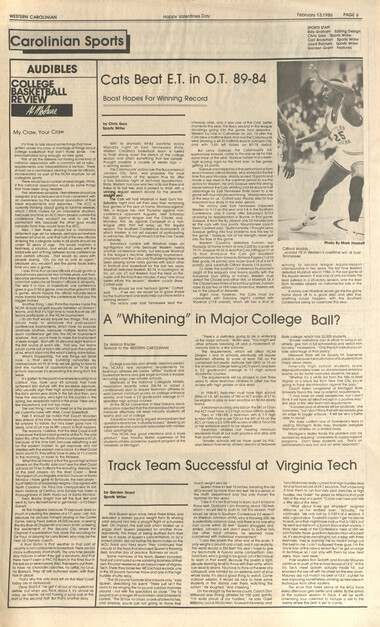

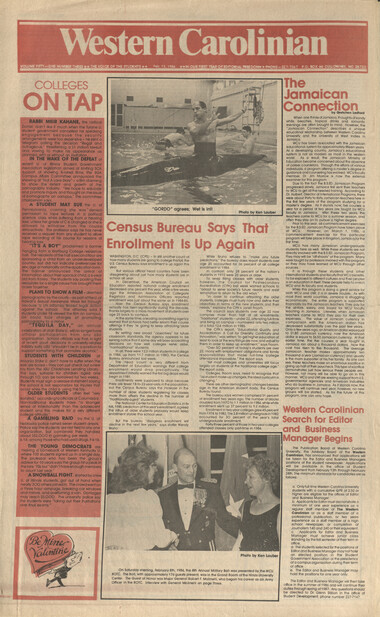
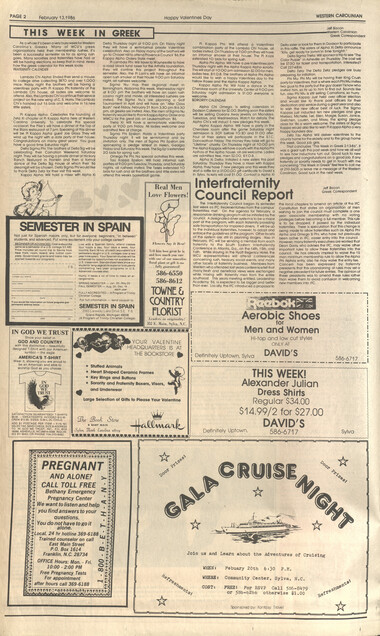
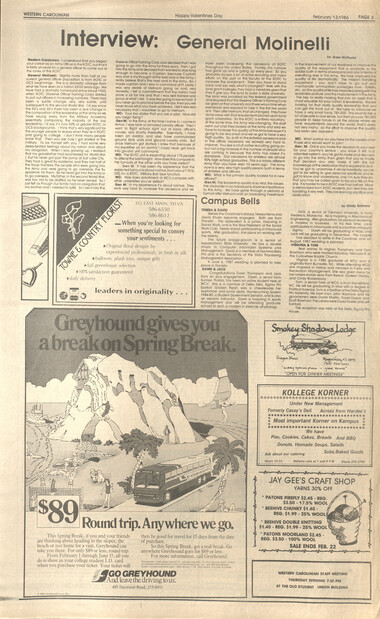
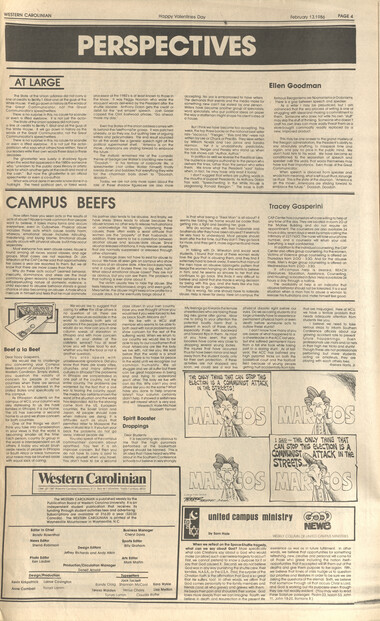
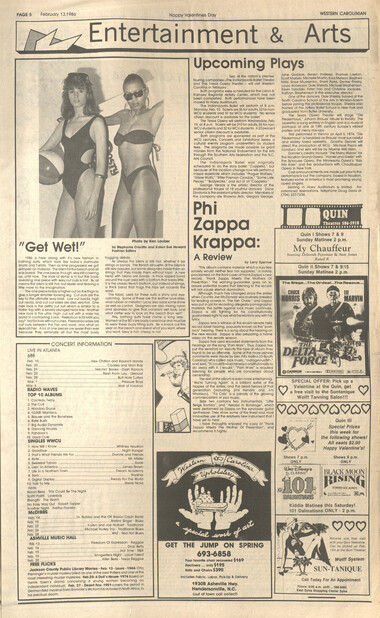
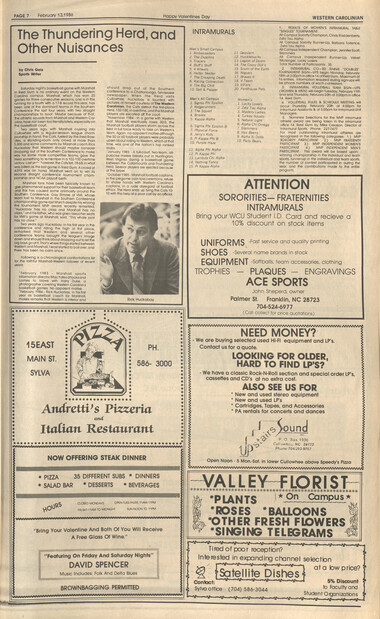
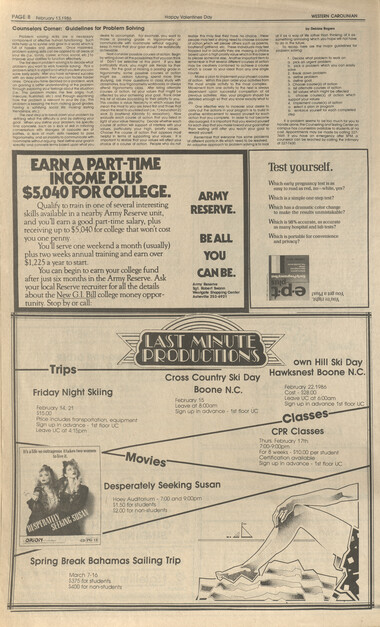

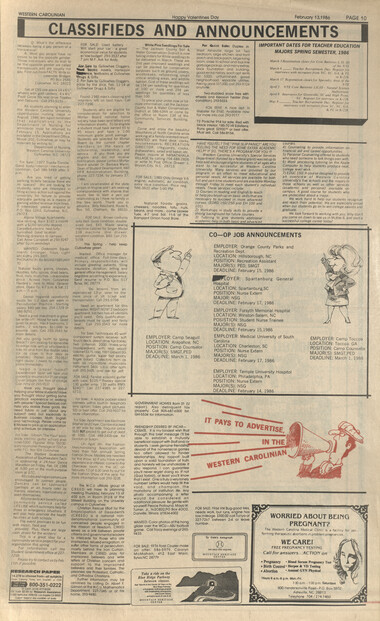
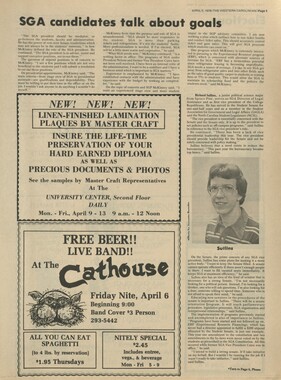
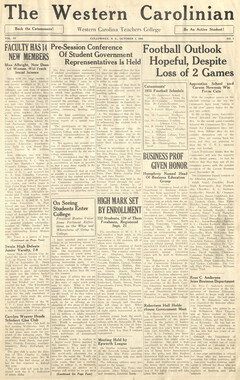
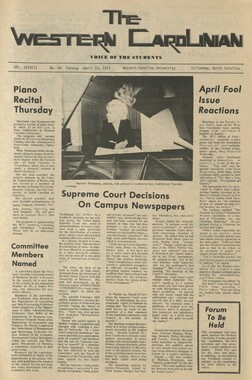
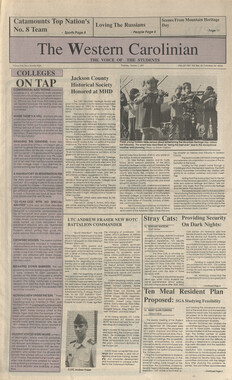
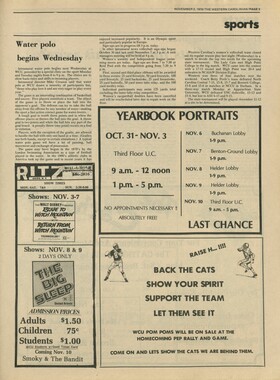
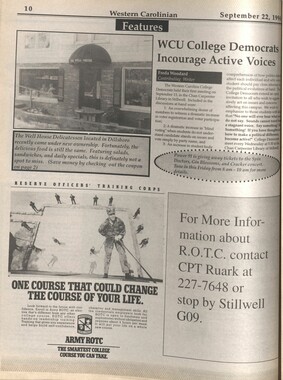
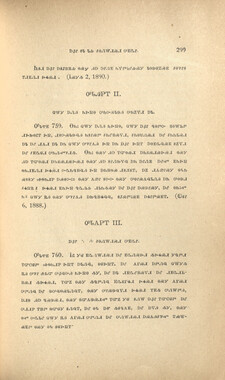
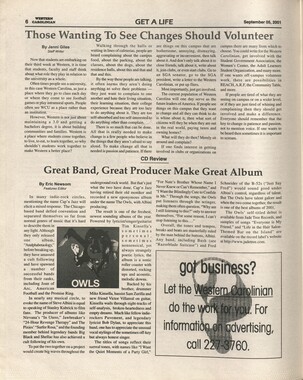
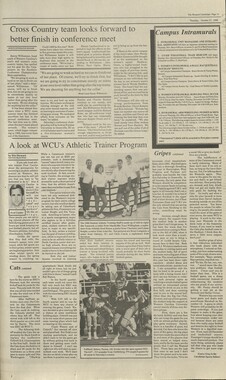
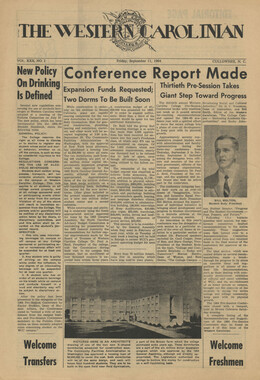
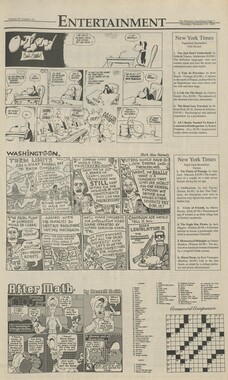
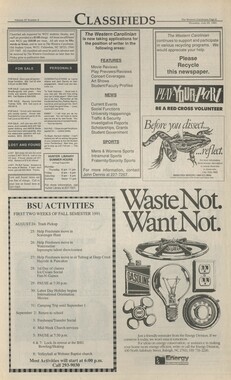
![hl_westerncarolinian_2004_[vol69_no03]_04.jpg](/media/w400h300/wcu_publications/hl_westerncarolinian_2004_[vol69_no03]_04.jpg)
